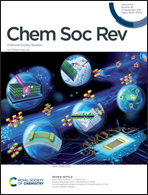Wetting-regulated gas-involving (photo)electrocatalysis: biomimetics in energy conversion
Abstract
(Photo)electrolysis of water or gases with water to species serving as industrial feedstocks and energy carriers, such as hydrogen, ammonia, ethylene, propanol, etc., has drawn tremendous attention. Moreover, these processes can often be driven by renewable energy under ambient conditions as a sustainable alternative to traditional high-temperature and high-pressure synthesis methods. In addition to the extensive studies on catalyst development, increasing attention has been paid to the regulation of gas transport/diffusion behaviors during gas-involving (photo)electrocatalytic reactions towards the goal of creating industrially viable catalytic systems with high reaction rates, excellent long-term stabilities and near-unity selectivities. Biomimetic surfaces and systems with special wetting capabilities and structural advantages can shed light on the future design of (photo)electrodes and address long-standing challenges. This article is dedicated to bridging the fields of wetting and catalysis by reviewing the cutting-edge design methodologies of both gas-evolving and gas-consuming (photo)electrocatalytic systems. We first introduce the fundamentals of various in-air/underwater wetting states and their corresponding bioinspired structural properties. The relationship amongst the bubble transport behavior, wettability, and porosity/tortuosity is also discussed. Next, the latest implementations of wetting-related design principles for gas-evolving reactions (i.e. the hydrogen evolution reaction and oxygen evolution reaction) and gas-consuming reactions (i.e. the oxygen reduction reaction and CO2 reduction reaction) are summarized. For photoelectrode designs, additional factors are taken into account, such as light absorption and the separation, transport and recombination of photoinduced electrons and holes. The influences of wettability and 3D structuring of (photo)electrodes on the catalytic activity, stability and selectivity are analyzed to reveal the underlying mechanisms. Finally, remaining questions and related future perspectives are outlined.



 Please wait while we load your content...
Please wait while we load your content...